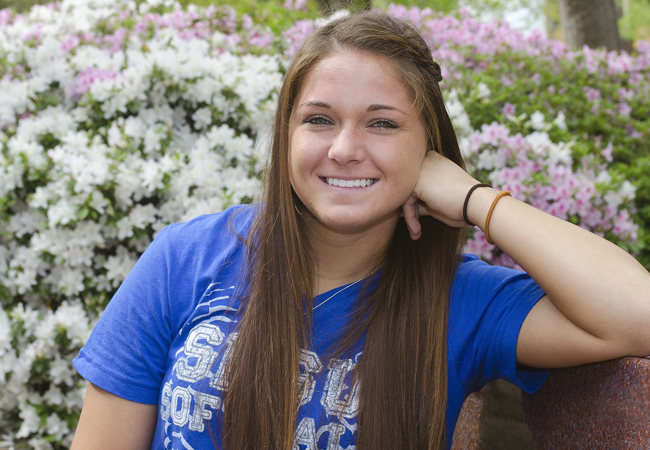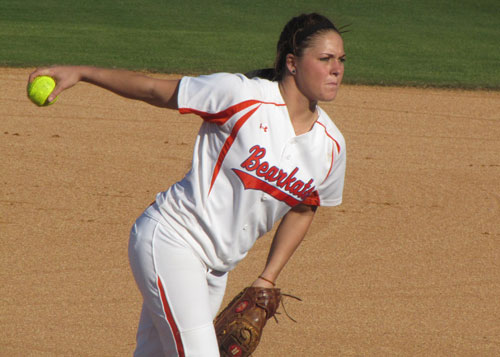SHSU Senior Becomes 'The Match,' A Bearkat Hero
March 14, 2012
SHSU Media Contact: Amy Barnett

Tomi Garrison had no idea what her future would hold when she agreed to have her mouth swabbed during a bone marrow donor drive in the spring of 2010.
The Sam Houston State University softball player and psychology major was a sophomore when the “Be The Match Registry” did a presentation in her health class, calling on volunteers to start the process that would determine if they had compatible bone marrow to someone who desperately needed it.
“My friend and I said ‘yeah we’ll do it,’ never thinking we’d be called on, because statistically the chances of us being a match were so slim,” said Garrison, now a senior at SHSU.
But the unlikely scenario became reality a year later when Garrison got an email that would soon change not only her life but also someone else’s.
“The email said I was a possible match and asked if I would do more testing. So I went in for testing at Baylor University Medical Center in Dallas, where they took a lot of blood and tested to see if the antigens matched up,” she said. “Even then the chances of being an accurate match weren’t good, but I was hoping I would be a match.”
Garrison’s hopes came true in October 2011, when she received word that she had compatible bone marrow to a 59-year-old woman who suffers from multiple myeloma.
She quickly agreed to become a donor for a woman she’d never met.
“My mom cries about everything,” said Garrison. “So she started crying because she was just proud of me because this was solely my decision.”
The tears continued when Garrison shared the news with SHSU health instructor Susie Stone and Roseanne Keathley, acting chair of the SHSU Department of Health and Kinesiology.
“We just screamed and cried,” Keathley said. “We were so excited that one of our students here in the health department was a match and that she was willing to take the time away from school to do this.”
After rigorous testing to make sure she was healthy enough to donate, Garrison took time off from school and softball practice to return to Dallas to begin the donation process.
Rather than donating marrow from her pelvic bone, which was the only marrow donation procedure until the early 1990s, Garrison was asked to donate peripheral blood stem cells. PBSC donation is a non-surgical, less painful method that has become the preferred means of marrow donation by doctors 76 percent of the time. Traditional marrow harvesting from the pelvic bone is still used often when donating to young children because it is more successful.
The PBSC procedure starts by giving donors a series of shots to increase his or her blood cell count.
“The medication given to peripheral stem cell donors is called Neupogen, also known by its generic name, filgrastim. It is designed to make your bone marrow produce an increased amount of immature stem cells that are needed to produce blood,” said Scott Simpson, donor center coordinator for Baylor University Medical Center, Dallas.
Garrison was given shots each day for five days, which caused her to have severe head and body aches, creating what she called “flu-like symptoms.” But she never complained or had second thoughts about becoming a donor. The day of the final injection was the day Garrison made the donation.
“The procedure usually takes four and a half to five hours. At Baylor we put our donors in a hospital bed where they can be comfortable,” said Simpson. “We put a needle in each arm. The blood goes out of one arm and into a machine that collects the top layer of the blood where the immature stem cells are located. Then the rest of the blood goes back into the donor’s other arm.”
 |
| Garrison, a pitcher for the SHSU Softball Team, has been playing for the last three years with a stress fracture. "She's a tough girl," said Paul Ridings, assistant athletic director for media relations. —Photo courtesy of SHSU Athletics. |
While 80 percent of donors complete the process in one day, others like Garrison, require two days due to the larger amount of stem cells requested by the transplant center. Although donors typically feel little pain during the procedure, Garrison admits it was tougher than she expected.
“I started crying because, for me, it hurt really bad. But I know my pain was nothing compared to the pain patients are going through when they’re taking chemo and everything else,” she said.
Recovery time after donating peripheral blood stem cells is typically a few days. Many donors are able to return to work the following day.
Guidelines of the “Be The Match Registry” allow donors to receive an update on the patient they’ve helped 30 days after the donation and then again six months following the procedure. If both the donor and patient agree, the two get the opportunity to meet one year following the stem cell transplant.
“I got my 30 day update right before Christmas, and they told me the transplant worked and she (the donor recipient) was able to go home from the hospital,” said Garrison. “I hate that I have to wait a year to meet her. I wish I had contact with her all of the time so I could know how she’s doing and how she’s feeling.”
While Garrison must be patient and wait for the opportunity to meet the woman she helped, she’s making the most of her time. She is now doing an internship within the department of health and kinesiology that is allowing her to focus on doing presentations about various donor programs.
“I want to get the word out about becoming a donor, especially in the athletics department, because most athletes are healthy and if they were a match, they’d most likely be able to donate,” said Garrison.
Her dedication is music to the ears of Wyn Johnson, manager of the Gulf Coast Marrow Donor program, which is contracted with the “Be The Match Registry.”
“It is very important that we get donors, because every year more than 10,000 people are diagnosed with life threatening illnesses like leukemia, lymphoma, and sickle cell anemia. Their best chance for a cure is a transplant,” Johnson said.
“Houston and surrounding areas have six million people, yet there are only nine and a half million donors on the nation-wide registry. That’s nothing in comparison to the population of the United States.”
Since tissue types are inherited, patients will most likely find a match from someone from their own ethnic background. Currently the “Be The Match Registry” is made up of 73 percent Caucasians, 10 percent Hispanics and 7 percent African Americans, with other ethnic groups making up the remaining 10 percent. Statistically, 93 percent of Caucasian patients find a match on the registry, but the match rate is much lower for other ethnic groups.
It is even more difficult for a multi-race patient to find a match.
The Gulf Coast Marrow Donor team will be teaming up with SHSU’s Colleges Against Cancer group the week of March 26, in hopes of adding more people to the registry. To register, all participants must do is complete a health history form and allow volunteers to collect your DNA through a swab of the inside of your cheek.
If someone is not healthy enough to join the registry, Johnson stressed the importance of volunteering your time or making a financial contribution. Adding someone to the registry costs “Be The Match” about $100. So if you are healthy enough to register, Johnson requests you only do so if you are committed to following through with a donation if you are identified as a match.
Tomi Garrison did not hesitate.
“We are just so proud of her as an individual. She did this knowing it is not a pleasant thing to go through and was totally selfless,” said Stone, who was teaching the health class Garrison was taking when she registered with “Be The Match.” “So we are so proud because she is such a good role model for other students across the country.”
Being a role model is not something Garrison was thinking about when she decided to become a donor; her motivation was simple.
“I just felt the need to help somebody,” Garrison said. “What if someone in my family needed bone marrow? I would want someone to do the same thing. It’s just the right thing to do.”
For more information on joining the “Be The Match Registry,” or to make a financial contribution or to volunteer, contact Johnson at 713.791.6220 or wjohnson@giveblood.org.
- END -
This page maintained by SHSU's Communications Office
Associate Director: Julia May
Manager: Jennifer Gauntt
Located in the 115 Administration Building
Telephone: 936.294.1836; Fax: 936.294.1834
Please send comments, corrections, news tips to Today@Sam.edu.

 SamWeb
SamWeb My Sam
My Sam E-mail
E-mail

